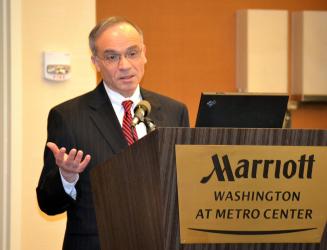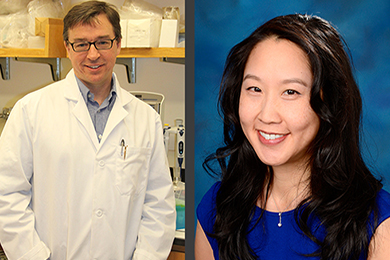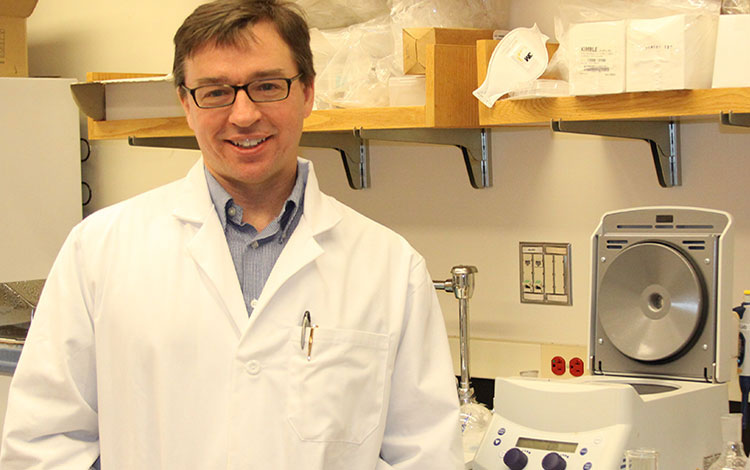School Hosts Conference on Critical Issues of ‘Biosimilars’
FDA to rule on complexities of copycat vaccines, blood therapies, toxin products, and other biologic therapies that are similar, but not exactly the same, as brand products.

By Steve Berberich
January 4, 2012
At an international conference on Critical Issues Related to Regulation of Follow-on Biologics hosted by the University of Maryland School of Pharmacy’s(UM) Center on Drugs and Public Policy held at the Washington (D.C.) Marriott Hotel at Metro Center on Dec. 15, leading pharmaceutical lawyers, professors, regulators, payers, and industry officials speculated on how impending federal guidelines might affect manufacturing and marketing of copycat medications made from living organisms.
Such biologic therapies include vaccines, serums, viruses, antitoxins, blood products, proteins, and certain organic products.
After more than a decade of controversy and debate by brand name and generic drug manufacturing factions over the complexities of writing legislation on so-called follow-on biologics or biosimilars that are not exactly the same as brand biologic therapies, the Food and Drug Administration (FDA) has promised to release “guidances” by January 2012.
Francis Palumbo, PhD, JD, a professor of pharmaceutical health services research and executive director of the Center, said, “I think people at this conference represented the best cross-section we could gather on this topic. And while FDA has still not yet issued guidances, we can engage in speculation today.”
Asking patients, physicians, pharmacists, and insurance providers to accept a biosimilar as a cheaper or at least an alternative for a medical condition is extremely complex, said Robert Dormer, JD, partner, Hyman, Phelps & McNamara, PC, of Washington, D.C. He wondered, “Will [FDA require] there be clinical trials for each indication [medical condition]? FDA will have to develop guidelines for user fees and performance goals,” said Dormer. “With all the qualifiers, I’m not sure the statute gives an advantage to the biosimilar maker.”
Generic drugs made from chemical compounds are regulated by FDA under the Hatch-Waxman Act of 1984, but biosimilars are not covered and required new legislation. This was included in the Affordable Care Act of 2010 giving FDA a “pathway” or authority to regulate them. Palumbo said that the biosimilars provision focused on patents to a large extent, but many scientific issues are unsolved and open for discussion.
Meanwhile, FDA guidances for biosimilars will evolve, with the agency starting out cautiously, said Dormer. “Definitions of biosimilars require animal studies, clinical studies, analytical studies,” he said. “FDA has the legal authority to waive any of these but most experts think it will be a while before the agency waives one or any of these,” he said.
In 2005, the European Union (EU) published biosimilars guidances for its countries, yet only a handful of products have been marketed, due largely to the complex issues surrounding safety, effectiveness, dosage, and substitution of the biosimilar for a known brand product, said Bruno Flamion, MD, PhD, chair of the Belgian Committee for Reimbursement of Medicines. In Europe, he said, limited educating of clinicians and physicians has slowed biosimilar marketing in some of the EU states.
“FDA is doing a better job in informing the health care providers. The gaps between FDA and clinicians are smaller, so maybe less education will be needed,” said Flamion.
Annette Stemhagen, DrPH, FISPE, senior vice president for safety, epidemiology, registries, and risk management at United BioSource Corp. of Blue Bell, Pa., added, “REMS [risk evaluation and mitigation strategies] will be tough, making communications and outreach education more important than ever.” Observing and possibly learning from the EU experience was a dominant topic of several speakers.
According to Flamion, the EU system “struggles the most” with immunogenity reactions, that is, how and if the patient’s immune system is accepting the biosimilar medication safely and efficaciously. He said the issue pushes to the forefront adequate testing of the biosimilar in clinical trials. “There is no way we can ignore using clinical trials purely because of this immunogenicity issue.”
“We use a system of scientific advice case-by-case, something somewhat lacking at FDA,” he said, adding that the EU system of approving biosimilars is based on science and thus is constantly evolving. The pending FDA guidances will indeed emphasize analytical data more than clinical data, said health and science attorney Sheila Walcoff, JD, principal of Goldbug Strategies, LLC of Washington, D.C. “Expect reliance on existing pharmacovigilance mechanisms,” she said, referring to post-marketing research strategies.
Walcoff stated that FDA “finished the guidances about a month ago” and that they are being reviewed at “higher levels of government to align with goals of the administration.” She said it won’t be long though, because “coming into an election year sometimes it is hard to get guidance out.”
Sheila Weiss, PhD, FISPE, a professor of pharmaceutical health services research at the School of Pharmacy, said the categories of biosimilars that companies are likely to advance through FDA approval will “bridge the gamut between preventative and lifesaving drugs.” She added that for biosimilars, the medical community needs new ways to communicate safety information, beyond what is on official prescription labels.
The issue of whether a biosimilar is interchangeable with a brand name drug will be important in analyzing future reports of adverse reactions, said Stemhagen. “Whose fault is it then?” she asked. Stemhagen and others referred to existing post-market studies of biologic medications called tumor necrosis factor blockers, which can compromise the body’s resistance to serious fungal infections. Stemhagen said, “Labeling is the first step in risk assessment.”
The future is now with determining how to approve biosimilars, she said, because 46 biotech therapeutic products are due to lose their patent protection by 2020. She asked rhetorically, “What post-market research will be required or needed on biosimilars and what to do about them changing with time? We can learn from those marketed in Europe.”



